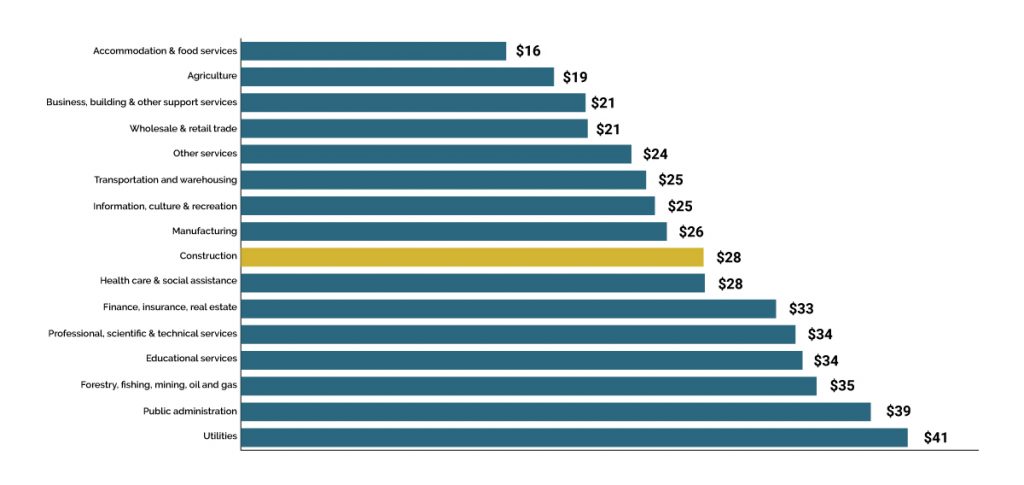Construction is a growing sector of Ontario’s economy, and unlike other expanding sectors, one that creates quality jobs. Good wages and decent working conditions are a result of the relatively high union density in the industry. The recently introduced Bill 66, Restoring Ontario's Competitiveness Act, will weaken these protections for workers in the sector, threatening job quality and health and safety.
Between 2007 and 2017, the construction sector’s contribution to Ontario’s total Gross Domestic Product (GDP) grew from 6% to 7%—that’s a significant increase of 16%.¹ In comparison, over the same period, the information and communications technology sector’s share of the GDP went from 2.2% to 2.5%, a 14% increase.
In 2007, the construction industry employed 469,125 workers, 6.4% of Ontario’s workforce. By 2017, the numbers of workers had gone up to 575,263, or 7.3% of the province’s workforce.² That’s notable job growth, especially since these are well-paid, decent jobs.
Graph 1 shows that construction workers earn middle-income salaries. In 2018, the average hourly wage of constructions workers in Ontario was $28.40—9% higher than the $26.10 average hourly wage for manufacturing and $1 more than the $27.40 for all industries.
Graph 1 | Average hourly wages by Industry, Ontario, 2018

Statistics Canada. Table 14-10-0064-01. Employee wages by industry, annual.
A major contributor to good wages and overall quality of jobs in the construction industry is its relatively high union density.
Table 1 shows that construction’s union density (31%) is more than twice as high as the average for the private sector, and above the average for all industries and for manufacturing. Construction does have lower union density than the public sector average.
Table 1| Union density, selected industries, Ontario, 2018 [table id=5 /] The union advantage in construction jobs is clear.
Unionized constructions workers earn an average hourly wage of $34, whereas non-unionized workers earn $26 per hour on average.³ That’s a 33% difference.
The average tenure for unionized construction workers is 77 months, in contrast to 66 months for non-unionized workers.⁴ That’s almost a year more of employment stability.
Unionized workers report working an average of 1.6 hours of unpaid overtime per week, while the average for non-unionized workers is 6.4 hours: amounting to four times more unpaid work.⁵
Employment insurance coverage is also higher for unionized workers (98%) than for their non-unionized counterparts (86%).⁶
Then there is health and safety, a key concern in the industry.
Between 2006 and 2012, unionized construction workers in Ontario reported 23% fewer injuries requiring time off work, and had a 17% lower rate of musculoskeletal injuries, and a 29% lower rate of grave injuries than non-unionized constructions workers.⁷
These differences have been attributed to unions’ education work in on-the-job hazards and occupational health, as well as to unions’ role in providing a secure environment for workers to report injuries.⁸ Unreported injuries, common in precarious jobs, can aggravate health conditions and prevent the implementation of health and safety measures.
Unions help to keep workers safe, and improve wages and benefits, making the construction industry a source of decent work.
Attacking job security and health and safety in the construction industry
Bill 66 continues the Ontario government’s attack on working people across the province. The proposed amendments to the Labour Relations Act would deem public sector entities including municipalities, school boards, hospitals, universities and colleges among others to be non-construction employers.
What this means is that it would strip construction workers of their membership in their trade unions and rob them of their collective agreements.
“Non-construction employer” provisions were first introduced under Mike Harris, opening the door for employers to obtain a declaration from the Ontario Labour Relations Board, ceasing the application of any collective agreement to which it was previously bound in the construction industry.
This change would negatively affect the construction industry, health and safety, and workers’ wages, and it would deepen precarious employment in the sector. The Ford government appears to be banding with the private construction lobby that has been pressuring governments to deregulate public procurement for decades.⁹
The Ford government is de-facto opening up a race to the bottom in construction. Non-unionized contractors will now be able to bid in major public construction projects. This will lead to higher injuries, lower wages and lower overall quality of jobs and performance.
The cost of lower wages, worse working conditions, and weaker trade unions will affect the province in the medium and long-term. Decreasing trade union density will also increase inequality, by weakening the capacity of workers to collectively demand better wages and safe working conditions.
¹ Statistics Canada. Table 36-10-0400-01. Gross domestic product (GDP) at basic prices, by industry, provinces and territories, percentage share; calculations by the authors.
² Labour Force Survey Public Use Microdata File; calculations by the authors.
³ Labour Force Survey Public Use Microdata File, Ontario, January-August 2018; calculations by the authors.
⁴ Ibid.
⁵ Ibid.
⁶ Employment Insurance coverage is defined as the share of contributors with valid job separation who had sufficient hours to qualify for the benefit.
⁷ Amick III, Benjamin; Hogg-Johnson, Sheilah; Latour-Villamil, Desiree; and Saunders, Ron (2015) “Protecting Construction Worker Health and Safety in Ontario, Canada. Identifying a Union Safety Effect” JOEM, Vol. 57, No.12, pp. 1337-1342.
⁸ Ibid.
⁹ See http://www.meritontario.com/advocacy/ for examples.
Bruno Dobrusin is coordinator of the One Million Climate Jobs campaign at the Green Economy Network. Ricardo Tranjan is a senior researcher with the Canadian Centre for Policy Alternatives’ Ontario office. Follow Ricardo on Twitter: @ricardo_tranjan







